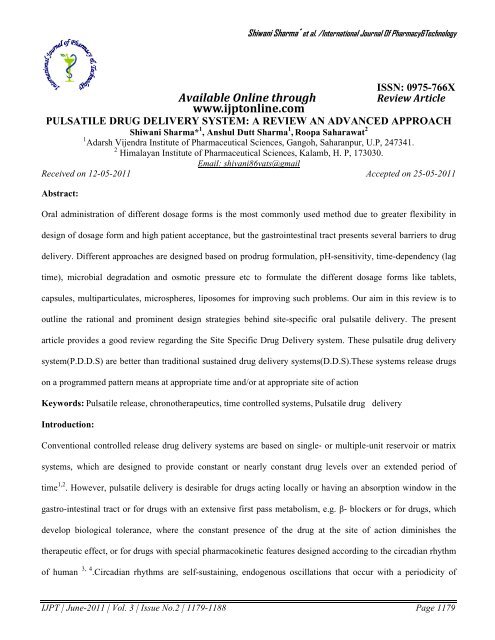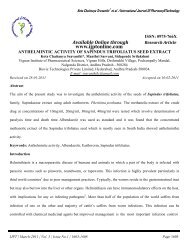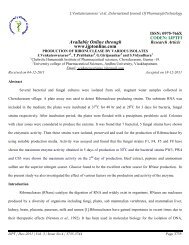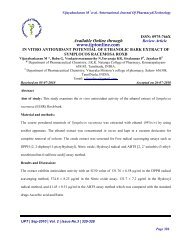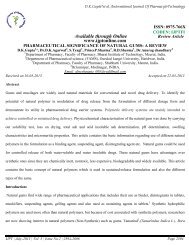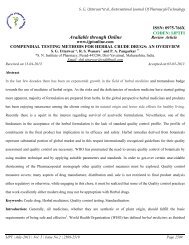Available Online through - International Journal of Pharmacy and ...
Available Online through - International Journal of Pharmacy and ...
Available Online through - International Journal of Pharmacy and ...
- No tags were found...
Create successful ePaper yourself
Turn your PDF publications into a flip-book with our unique Google optimized e-Paper software.
Examples <strong>of</strong> diseases cured by P.D.D.SShiwani Sharma * et al. /<strong>International</strong> <strong>Journal</strong> Of <strong>Pharmacy</strong>&TechnologyPeptic ulcer this disease is effected by circadian rhythm <strong>of</strong> body <strong>and</strong> Acid secretion is high in the afternoon <strong>and</strong>at night.Asthma circadian rhythm also have effect on this disease as Precipitation <strong>of</strong> attacks occurs during night or atearly morning hours.Cardiovascular diseases BP is at its lowest during the sleep cycle <strong>and</strong> Nitroglycerin, Calcium channel risessteeply during the early morning awakening period.Arthritis Pain in the morning <strong>and</strong> more pain at night.Diabetes mellitus Increase in the blood sugar level after meal.Attention deficit syndrome Increase in DOPA level in afternoonHypercholesterolemia Cholesterol synthesis is generally higher HMG CoA reductase inhibitors during nightthan during day time 13-14 .Constitution OF P.D.D.SConstitution <strong>of</strong> active core:Active core <strong>of</strong> the novel dosage form may comprise an inert particle such as a sugar sphere or a cellulose spherewith a desired mean particle size. Alternatively, drug- containing cores (microgranules, pellets or micro-tablets)may be prepared by rotogranulation, granulation followed by extrusionspheronization or compression intomicro-tablets (about 1 to 2 mm in diameter) <strong>of</strong> the drug, a polymeric binder <strong>and</strong> optionally fillers/diluents. Thedrug load in the cores could be as high as 60 percent by weight in drug-layered beads <strong>and</strong> as high as 95 percentin pellets <strong>and</strong> micro-tablets.Solvent Medium:An aqueous or a pharmaceutically acceptable solvent medium (e.g. water or acetone/water) may be used forpreparing core particles, <strong>and</strong> the drug substance may be dissolved or suspended in this coating formulation at asolid content <strong>of</strong> about 10 to 30 percent by weight depending on the viscosity <strong>of</strong> the coating formulation.Generally, the individual polymeric coating applied on the active cores from a solution or an aqueous suspensionIJPT | June-2011 | Vol. 3 | Issue No.2 | 1179-1188 Page 1181
Shiwani Sharma * et al. /<strong>International</strong> <strong>Journal</strong> Of <strong>Pharmacy</strong>&Technologywill vary from about 1.5 to 60 percent by weight depending on the nature <strong>of</strong> the active <strong>and</strong> required sustainedrelease duration 15 .CLASSIFICATION OF P.D.D.S DEPENDING UPON TARGET RELEASESite-Specific SystemsThe drug in such systems is released at the desired site within the intestinal tract (e.g., the colon). Environmentalfactors like pH or enzymes present in the intestinal tract control the release <strong>of</strong> a site-controlled system.Time-Controlled DevicesThe drug in such systems is released after a well-defined time period. The drug release from time-controlledsystems is controlled primarily by the delivery system <strong>and</strong> not by the environment 16 . In time controlled drugdelivery systems pulsatile release is obtained after a specific time interval in order to mimic the circadianrhythm. Such type <strong>of</strong> pulsatile drug delivery system contains two components: one is <strong>of</strong> immediate release type<strong>and</strong> other one is a pulsed release type. Various methodologies such as time controlled devices with rupturablecoating layer, erodible coating layer can be used for time controlled pulsatile devices. 17-19Stimuli induced pulsatile systemsIn these systems there is release <strong>of</strong> the drug after stimulation by any biological factor like temperature,or anyother chemical stimuli 20 . These systems are further classified in to temperature induced systems <strong>and</strong> chemicalstimuli induced system, on the basis <strong>of</strong> stimulus.Temperature induced systemsThermo-responsive hydrogel systems have been developed for pulsatile release. In these systems polymerundergoes swelling or deswelling phase in response to the temperature which modulate drug release in swollenstate 21Drug release from intelligent gels responding to antibody concentrationThere are numerous kinds <strong>of</strong> bioactive compounds which exist in the body. Recently, novel gels were developedwhich responded to the change in concentration <strong>of</strong> bioactive compounds to alter their swelling/deswellingcharacteristics. Special attention was given to antigen-antibody complex formation as the cross-linking units inthe gel, since such interaction are very specific. Utilizing the difference in association constants betweenIJPT | June-2011 | Vol. 3 | Issue No.2 | 1179-1188 Page 1182
Shiwani Sharma * et al. /<strong>International</strong> <strong>Journal</strong> Of <strong>Pharmacy</strong>&Technologypolymerized antibodies <strong>and</strong> naturally derived antibodies towards specific antigens, reversible gelswelling/deswelling <strong>and</strong> drug permeation changes occurs 22PH sensitive drug delivery systemSuch type <strong>of</strong> pulsatile drug delivery system contains two components one is <strong>of</strong> immediate release type <strong>and</strong> otherone is pulsed release which releases the drug in response to change in pH. In case <strong>of</strong> pH dependent systemadvantage has been taken <strong>of</strong> the fact that there exists different pH environment at different parts <strong>of</strong> thegastrointestinal tract. By selecting the pH dependent polymers drug release at specific location can be obtained.Examples <strong>of</strong> pH dependent polymers includes cellulose acetate phthalate, polyacrylates, sodiumcarboxymethylcellulose. These polymers are used as enteric coating materials so as to provide release <strong>of</strong> drug inthe small intestine 23 .Externally regulated systemsFor releasing the drug in a pulsatile manner, another way can be the externally regulated systems in which drugrelease is programmed by external stimuli like magnetism, ultrasound, electrical effect <strong>and</strong> irradiation 24 .CLASSIFICATION OF P.D.D.S DEPENDING UPON TECHNOLOGY USEDFrom technological point <strong>of</strong> view pulsatile drug release system are further divided to single or multiple unitssystem.Single Unit System:Single unit system can be <strong>of</strong> following types:Capsule BasedSuch type <strong>of</strong> drug delivery system for administering a drug in controlled pulse doses to an aqueous environmentin the body <strong>of</strong> a living being. The formulation comprises <strong>of</strong> one or more, <strong>and</strong> preferably less than ten, individualdrug-containing subunits in a unitary drug depot, such as a tablet or capsule. The individual subunits aredesigned to dissolve at different sites <strong>and</strong>/or times in the gastrointestinal tract to release pulse doses <strong>of</strong> drug intothe portal system in an analogous manner to the rate <strong>of</strong> release from an immediate release dosage formadministered according to an appropriate dosing schedule. The dissolution time <strong>of</strong> the individual subunits can beIJPT | June-2011 | Vol. 3 | Issue No.2 | 1179-1188 Page 1183
Shiwani Sharma * et al. /<strong>International</strong> <strong>Journal</strong> Of <strong>Pharmacy</strong>&Technologycontrolled by several methods including the provision <strong>of</strong> pHsensitive enteric coatings <strong>and</strong> permeabilitycontrolledcoatings 25 .Osmosis BasedOsmotic delivery capsules ("osmotic pumps") function by virtue <strong>of</strong> walls which selectively pass water into thecapsule reservoir. Absorption <strong>of</strong> water by the capsule <strong>through</strong> these walls is driven by a water-attracting agent inthe capsule interior which creates osmotic pressure across the capsule wall. The water-attracting agent may bethe beneficial agent itself whose controlled release is sought, but in most cases, it is a separate agent specifical1yselected for its ability to draw water, <strong>and</strong> this separate agent is being isolated from the beneficial agent at one end<strong>of</strong> the capsule 26 .Eroding/Soluble Barrier SystemSuch a system uses the degradation products <strong>of</strong> one polymer to trigger the release <strong>of</strong> the active compound fromanother polymer. The delayed release <strong>of</strong> the active compound is achieved without using a barrier system thatrequires complex <strong>and</strong> sophisticated formulation techniques. The proposed formulation comprises the biologicallyactive compound having a chemical structure with hydrogen bonding sites dispersed in a biocompatible,hydrolytically degrading polyarylate. Bonding interactions between the polymer <strong>and</strong> the active compound areused to lock the active compound into the polymeric matrix. In order to control the time <strong>of</strong> release frompolyarylates, a second biocompatible polymer but less hydrophobic than polyarylates is also used. The secondpolymer can be degraded into acidic byproducts into the matrix. This is necessary because the hydrogen bondinginteractions can be weakened under conditions <strong>of</strong> low pH, resulting in the release <strong>of</strong> the peptide.Degradationproducts lower the pH <strong>of</strong> the matrix, causing an interruption in the interactions <strong>and</strong> the subsequent release <strong>of</strong>active compound 27 .Rapturable LayersMehta described a novel formulation for once daily administration (prior to sleeping) that provides an initialdelay followed by controlled release <strong>of</strong> the drug. A method for preparing a time specific delayed, controlledrelease formulation <strong>of</strong> dosage is also provided which method includes coating a single pellet with at least onedosage layer, which is coated by at least one seal coat <strong>and</strong> at least one outer rate controlling layer <strong>of</strong> a waterIJPT | June-2011 | Vol. 3 | Issue No.2 | 1179-1188 Page 1184
Shiwani Sharma * et al. /<strong>International</strong> <strong>Journal</strong> Of <strong>Pharmacy</strong>&Technologysoluble polymer coat. The formulation affords excellent bioavailability while avoiding fluctuating blood levels.By that way, it is possible to maintain drug plasmatic concentrations in a desired, effective range in a circadianfashion while simplifying the administration <strong>of</strong> the drug to only once daily 28 .Multiple Unit System:Multiple unit system can be <strong>of</strong> following types:Systems Based on Change in Membrane PermeabilityIn such kind <strong>of</strong> formulation <strong>of</strong> a multiparticulate pharmaceutical form <strong>of</strong> a delayed <strong>and</strong>/or pulsed release,enabling to obtain the onset <strong>of</strong> the availability <strong>of</strong> the active ingredient within 4 to 8 hours after the ingestion <strong>of</strong>the pharmaceutical form, <strong>and</strong> then a progressive release <strong>of</strong> the totality <strong>of</strong> the active ingredient within the 8 to 20following hours. The formulations is in the form <strong>of</strong> spheroids consisting <strong>of</strong> a neutral spherical core comprising afirst coating based on a mixture <strong>of</strong> at least one hydrosoluble polymer <strong>and</strong> <strong>of</strong> at least one non hydrosolublepolymer <strong>through</strong>out which the constitutive particles <strong>of</strong> an active ingredient are uniformly distributed. A secondcoating based on at least two pH independent polymers presenting rates <strong>of</strong> permeability different from oneanother with respect to the gastric <strong>and</strong> intestinal mediums, was also used 29 .Systems with Rapturable CoatingBlum described a controlled release oral dosage form <strong>of</strong> acetylsalicylic acid (aspirin) capable <strong>of</strong> delaying therelease <strong>of</strong> the drug until a predetermined time interval after ingestion. The following is prepared in such amanner that, after ingestion, there will be no release for a preset time interval (5-8 hours). Thus, if taken atbedtime it reaches optimal therapeutic blood levels at a time in the early morning when the events leading up to avascular obstruction culminating in a heart attack or stroke are most commonly occurring after the drug is takenin the evening. The formulation comprises <strong>of</strong> an aspirin core together with a swelling agent <strong>and</strong> a frangiblecoating protecting aspirin from dissolution by gastrointestinal fluids having water soluble <strong>and</strong> insolubleproperties 30 .Miscellaneous pulsatile systemsSome really novel systems <strong>of</strong> pulsatile release has also been proposed. For example, Weinbach <strong>and</strong> coworkersdescribed a delayed release oral formulation (a capsule, tablet, compression coated tablet or bilayer tablet)IJPT | June-2011 | Vol. 3 | Issue No.2 | 1179-1188 Page 1185
Shiwani Sharma * et al. /<strong>International</strong> <strong>Journal</strong> Of <strong>Pharmacy</strong>&Technologycomprising at least two populations <strong>of</strong> carrier particles where the first population comprises a biologically activesubstance <strong>and</strong> a penetration enhancer (absorption enhancer), <strong>and</strong> the second population comprises a penetrationenhancer <strong>and</strong> a delayed release coating or matrix. The first population is released from the formulation at a firstlocation in the intestine <strong>and</strong> quickly release the biologically active substance <strong>and</strong> the penetration enhancer. Thepenetration enhancer promotes absorption <strong>of</strong> the biologically active substance; however, because the enhancer isquickly absorbed, there is <strong>of</strong>ten an insufficient amount <strong>of</strong> enhancer to promote absorption <strong>of</strong> the entire dose <strong>of</strong>biologically active substance. The second population <strong>of</strong> carrier particles comprise an enteric outer coating whichresists degradation in the stomach <strong>and</strong> dissolves in the intestinal lumen <strong>and</strong> thus it is effective in protecting thenucleic acid from pH extremes <strong>of</strong> the stomach, or in releasing the nucleic acid over time to optimize the deliverythere<strong>of</strong> to a particular mucosal site 31 .Current & future developmentsCurrently various pulsatile technologies have been developed on the basis <strong>of</strong> methodologies as discussedpreviously. These includes OROS® technology, CODAS® technology, CEFORM® technology, DIFFUCAPS®technology, Three-dimensional printing®, timerx® etc 32 . Pulsatile-release formulations have many advantagesover immediate-release formulations. With these formulations, frequent drug administrationcan be avoided, <strong>and</strong>patient compliance can correspondingly be improved. In the field <strong>of</strong> drug delivery, increased attention hasrecently been focused on the potential <strong>of</strong> systems that are able to release drugs after a programmable lag phasecommencing at administration time, i.e., in a pulsatile mode. During the last two decades, technologies to ensuretime-controlled pulsatile release <strong>of</strong> bioactive compounds have been developed. The future <strong>of</strong> chronotherapeutics<strong>and</strong> more specifically the future <strong>of</strong> delivering drugs in a pulsatile manner seem to be quite promising as in certaindisease states pulsatile release exhibit several advantages over the traditional zero or first order drug deliverymechanisms. Pulsatile drug delivery systems can be either time controlled or site-specific, single or multipleunits. At the moment pulsatile release (site or time specific) most <strong>of</strong>ten is achieved by using different polymersin coating layers or by changing the coating thickness. From technological point <strong>of</strong> view, multiparticulatesystems seem to be more efficient than single-unit dosage forms in achieving pulsatile drug delivery <strong>and</strong> it canbecome even more sophisticated when coating technologies are incorporated. The authors <strong>of</strong> this paper believeIJPT | June-2011 | Vol. 3 | Issue No.2 | 1179-1188 Page 1186
Shiwani Sharma * et al. /<strong>International</strong> <strong>Journal</strong> Of <strong>Pharmacy</strong>&Technologythat an increasing number <strong>of</strong> multiparticulate coated systems would become commercially available in the yearsto come.References1. Daumesnil R. Marketing considerations for multiparticulate drug delivery systems. In: Ghebre‐Sellassie,editors.Multiparticulate Oral Drug Delivery, Marcel Dekker, New York, 1994, pp 457– 474.2. Qiu Y, Zhang G. Research <strong>and</strong> development aspects <strong>of</strong> oral controlled‐release dosage forms. Wise DL,editor. In: H<strong>and</strong>book <strong>of</strong> Pharmaceutical Controlled Release Technology, Marcel Dekker, New York,2000, pp 465–504.3. Rouge N, Buri P, Doelker E. Drug absorption sites in the gastrointestinal tract <strong>and</strong> dosage forms forsite‐specific delivery. Int. J. Pharm. 1996; 136: 117– 139.4. Lemmer B. Chronopharmacokinetics: implications for drug treatment. J. Pharm. Pharmacol. 1999; 51:887–890.5. Jha N, Bapat S, Chronobiology <strong>and</strong> chronotherapeutics. Kathm<strong>and</strong>u Uni. Med. J.2004; 2 (8): 384-388.6. Peppas NA, Leob<strong>and</strong>ung W. Stimuli-sensitive hydrogels: ideal carriers for chronobiology <strong>and</strong>chronotherapy. J Biomat Sci Polym. 2004; 15: 125-144.7. Jason T. Recent trends in oral drug delivery. Drug Deliv Report Autumn/Winter. 2005; 24-27.8. Ayres JW.: US20046733784. 2004.9. Chen X , Jun Shou Z, Yun MO. Calcium pectinate capsule for colon specific drug delivery. Drug Dev.Ind. Pharm. 2005; 31:127–134.10. Chourasia MK, Jain SK. Pharmaceutical approaches to colon targeted drug delivery systems. J. Pharm.Pharmaceut.Sci. 2003; 6: 33–66.11. Zhang Z, Wu F, Zhang Y. A novel pulsed‐release system based on swelling <strong>and</strong> osmotic pumpingmechanism, <strong>Journal</strong> <strong>of</strong> Controlled Release. 2003; 89: 47–55.12. Bikiaris D, Karavas E, Georgarakis E. Application <strong>of</strong> PVP/HPMC miscible blends with enhancedmucoadhesive properties for adjusting drug release in predictable pulsatile chronotherapeutics, Eur. J.Pharm <strong>and</strong> Biopharm. 2006; 64: 115–126.IJPT | June-2011 | Vol. 3 | Issue No.2 | 1179-1188 Page 1187
Shiwani Sharma * et al. /<strong>International</strong> <strong>Journal</strong> Of <strong>Pharmacy</strong>&Technology13. Hermida RC, Ayala DE, Calvo C, Adv. Drug Del. Rev. 2007.14. Lemmer J. Control. Rel. 1991; 16: 63-74.15. Gazzaniga A, Palugan L, Foppoli A, Sangalli ME. Oral pulsatile delivery systems based on swellablehydrophilic polymers. Eur J Pharm Biopharm 2008; 68: 11-18.16. Saigal N, Ali J, Ahuja A, Babbota S. Site Specific Chronotherapeutic Drug Delivery Systems: A PatentReview. Recent Patents on Drug Delivery & Formulation 2009;3: 64-70.17. Thombre AG, Appel LE, Chidlaw MB. J. Control. Rel 2004; 94:75-89.18. Gazzaniga A, Paluga L, Foppoli A. Eur. J. Pharm. <strong>and</strong> Biopharm 2007.19. Sangalli ME, Maroni A, Foppoli A. European <strong>Journal</strong> <strong>of</strong> Pharmaceutical Sciences 2004; 22: 469-476.20. Siegel RA, Pitt CG. J. Control. Rel 1995; 33:173-188.21. Kikuchi A, Okano T. Adv. Drug Del. Rev. 2002; 54: 53-77.22. Miyata T, Asami N, Uragami T . Nature 1999; 3: 766-769.23. Mastiholimath VS, D<strong>and</strong>agi PM, Jain SS. Int. J. pharm 2007; 328:49-56.24. Saslawski O, Weigarten C, Benoit JP. Life Sci 1988; 42:1521.25. Amidon GL, Leesman GD. US5229131. 1993.26. Magruder PR, Barclay B. US4777049. 1988.27. Kohn JB, Schachter DM. US20067326425. 2006.28. Mehta AM. US20056926909. 2005.29. Gendrot E, Cousin G, Ragot F, Clee-Bouvet MC.US20036039979. 2003.30. Blum AS. US20036663896B1. 2003.31. Weinbach S, Tillman LG, Geary RS, Hardee GE. US2005196443. 2005.32. Sharma S, Pawar A. Int. J. pharm. 2006; 313.Corresponding Author:Shiwani Sharma*,Email: shivani86vats@gmail.comIJPT | June-2011 | Vol. 3 | Issue No.2 | 1179-1188 Page 1188


